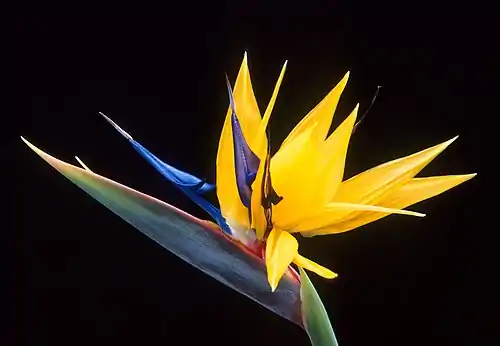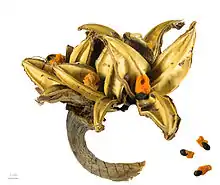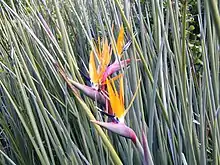Strelitzia
Strelitzia /strɛˈlɪtsiə/[3] is a genus of five species of perennial plants, native to South Africa. It belongs to the plant family Strelitziaceae.[4] A common name of the genus is bird of paradise flower/plant, because of a resemblance of its flowers to birds-of-paradise. In South Africa, it is commonly known as a crane flower.
| Strelitzia | |
|---|---|
 | |
| Scientific classification | |
| Kingdom: | Plantae |
| Clade: | Tracheophytes |
| Clade: | Angiosperms |
| Clade: | Monocots |
| Clade: | Commelinids |
| Order: | Zingiberales |
| Family: | Strelitziaceae |
| Genus: | Strelitzia Banks[1][2] |
| Type species | |
| Strelitzia reginae | |
| Species | |

Two of the species, S. nicolai and S. reginae, are frequently grown as houseplants.[5] It is the floral emblem of the City of Los Angeles and is featured on the reverse of the South African 50-cent coin.
Taxonomy
The genus was named by Joseph Banks in honour of the British queen Charlotte of Mecklenburg-Strelitz.[6][7]
Description
The species S. nicolai is the largest in the genus, reaching 10 m (33 ft) tall, with stately white and blue flowers;[8] the other species typically reach 2.0 to 3.5 m tall, except S. caudata, which is a tree of a typically smaller size than S. nicolai.
The leaves are large, 30–200 cm long and 10–80 cm broad, similar to a banana leaf in appearance, but with a longer petiole, and arranged strictly in two ranks to form a fan-like crown of evergreen foliage.
The flowers are produced in a horizontal inflorescence emerging from a stout spathe.
Biology and propagation
They are pollinated by sunbirds and blue-faced honeyeaters, which perch on and drink from the spathe. The weight of the bird when standing on the spathe opens it to release the pollen onto the bird's feet, which is then deposited on the next spathe it visits. Strelitzia species lack natural insect pollinators; in areas without sunbirds, plants in this genus generally need hand pollination to successfully set seed.[9]
Species and hybrids
Five species are recognised, although one—S. juncea—has been shown to be genetically nested within another, S. reginae. It is possibly a mutation that is in the process of speciating.[10]
| Image | Scientific name | Common name | Native distribution |
|---|---|---|---|
 | Strelitzia alba (syn. S. augusta) | White bird of paradise | Garden Route along the southernmost coastal regions of the Eastern and Western Capes in South Africa |
.jpg.webp) | Strelitzia caudata | Mountain strelitzia | Chimanimani Mountains of Zimbabwe south to Mozambique, the Northern Provinces of South Africa, and Eswatini |
 | Strelitzia nicolai | White bird of paradise or giant bird of paradise; wild banana; blue-and-white strelitzia[8] | Mozambique, Botswana, Zimbabwe,and Eastern South Africa from the Great Fish River northwards to Richards Bay |
.jpg.webp) | Strelitzia reginae (syn. S. parvifolia) | Strelitzia, bird of paradise, or crane lily | South Africa (the Cape Provinces and KwaZulu-Natal) |
 | Strelitzia juncea (Ker Gawl.) | African desert banana[11] | South Africa near Uitenhage, Patensie, and just north of Port Elizabeth |
- Strelitzia × kewensis (hybrid between S. reginae and S. augusta)
Allergenicity
Plants in the genus Strelitzia produce no wind-borne pollen, and have an OPALS allergy scale rating of 1, meaning a very low risk of causing allergic reaction.[9]
Symbolism
Strelitzia's flower language has many meanings, including success, freedom, immortality, loyalty, love, thoughtfulness and optimism. It is also a symbol of the 9th wedding anniversary[12] Freedom - Strelitzia symbolizes freedom and overcoming difficulties, reminding people not to stick to the present, but to see a wider world
Loyalty - Strelitzia symbolizes loyalty to a lover, and people present Strelitzia to their partners on the 9th anniversary of marriage to express their wholeheartedness[13]
Optimism - Strelitzia chinensis symbolizes optimism and positive energy, and inspires people not to give up when they are in trouble
Success - Strelitzia is a symbol of success in life and is given when congratulating someone on an important moment in life such as graduating from college[14]
Journal
Strelitzia is also the name of the botanic journal of the Pretoria-based National Botanical Institute,[15] which has since been converted into the South African National Biodiversity Institute (SANBI). The Strelitzia journal replaced Memoirs of the Botanical Survey of South Africa and 'Annals of the Kirstenbosch Botanic Gardens.[16]
References
- "Strelitzia Banks". Plants of the World Online. The Trustees of the Royal Botanic Gardens, Kew. n.d. Retrieved July 15, 2022.
- "Strelitzia Banks". Catalogue of Life. Species 2000. n.d. Retrieved July 15, 2022.
- Sunset Western Garden Book, 1995:606–607, Sunset Books
- "Tropical Flower Guide". Retrieved 30 November 2012.
- "Our House Plants - Bird of Paradise". Retrieved 18 July 2014.
- "Strelitzia reginae Banks". Plants of the World Online. 2017. Retrieved 27 May 2021.
- "Strelitzia reginae". pza.sanbi.org. August 2011. Retrieved 27 May 2021.
- Eliovson, Sima (1981). Shrubs, trees, and climbers. Macmillan South Africa. ISBN 0-86954-011-4. Retrieved 12 September 2009.
- Ogren, Thomas (2015). The Allergy-Fighting Garden. Berkeley, CA: Ten Speed Press. p. 200. ISBN 978-1-60774-491-7.
- Cron, Glynis V.; Pirone, Cary; Bartlett, Madelaine; Kress, W. John; Specht, Chelsea (2012). "Phylogenetic Relationships and Evolution in the Strelitziaceae (Zingiberales)". Systematic Botany. 37 (3): 606–619. doi:10.1600/036364412X648562. S2CID 17046806.
- Strelitzia juncae, Royal Botanic Gardens, Kew
- "Strelitzia". The Joy of Plants. Retrieved 2022-12-02.
- "Bird of Paradise Meaning and Symbolism". FTD.com. 2016-08-18. Retrieved 2022-12-02.
- "Bird of Paradise Flower – Meaning, Symbolism and Colors". Retrieved 2022-12-02.
- Strelitzia. 1994. OCLC 478273483. Retrieved 22 August 2021.
{{cite book}}:|website=ignored (help) - "Strelitzia". SANBI. Retrieved 22 August 2021.
External links
 Media related to Strelitzia at Wikimedia Commons
Media related to Strelitzia at Wikimedia Commons